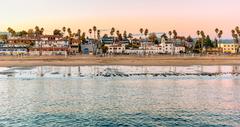Located in historic Charleston, Middleton Place is a former rice plantation that is located along the Ashley River. Middleton Place is divided among the following attractions: Plantation Stableyards, Gardens, and Museum. The Plantation Stableyards are where slaves used to carry out chores and take care of the animals. Touring the Stableyards gives people a glimpse of what it was like for enslaved people during the 18th and 19th centuries. Scroll to see the full list with photos or jump to the table of contents.
History

In the 1730s, planter John Williams began building his house at Middleton Place. Williams passed away shortly after construction, and the plantation was passed down to his daughter Mary Williams. In 1741, around the same time when the main house was finished, Mary married Henry Middleton. Immediately, Henry became intrigued by Middleton Place and wanted to make some adjustments to the house and land.
In an effort to have the most magnificent home and gardens in the neighborhood, Middleton hired Simms, a gardener from England. Together, Middleton and Simms created a luxurious garden with “Butterfly Lakes” and a twist of classic designs from Dezallier d’Argenville.
When Mary passed away in 1761, Henry passed down Middleton Place to Arthur, his son, and moved towards northern South Carolina. Arthur was active in the American Revolution in the sense that he signed the Declaration of Independence in 1776. In 1780, British troops invaded Charleston, and robbed Middleton Place. They even captured and imprisoned Arthur, and destroyed many of the architectural elements. After one year of imprisonment, Arthur was released, and in 1783, the British troops signed a surrender agreement at Middleton Place.
Throughout Arthur’s ownership of Middleton Place, he achieved many accomplishments. The first being the importation of water buffalo. These water buffalo came from Constantinople and are thought to be the first water buffalo that were imported into the United States. Those water buffalo were used as an effort to find the most efficient draft animal. Then, in 17866 Arthur and his friend Andre Michaux, planted the first camellias in a home garden in the United States.
More History

When Arthur passed away in 1846, he gave the acreage to his son Williams. Fourteen years later, Williams agreed and even signed the Ordinance of Secession, which was South Carolina’s way of seceding from the United States. This ultimately led to the Civil War and infamous Fort Sumter attack. Towards the end of the Civil War, Union forces came into Charleston, found Middleton Place, and burned it to the ground. As for the animals, the troops used approximately half of the water buffalo for food, and took the other half to what became the famous Central Park Zoo.
A few years after Middleton Place had been destroyed, Williams began restoring part of it. Since Williams had insufficient funds and limited resources, he decided to use the south flanker as his main residence. When Williams passed away in 1883, the home and gardens were given to his wife Susan. But, three years after Williams’ death, the infamous Charleston earthquake occurred and completely destroyed the home and gardens, as well as any hope of quickly restoring the land.
Minor restorations began in 1900, when Williams’ daughter Elizabeth was given Middleton Place. Majority of the restorations were made possible by John Julius Pringle Smith and his wife Heningham. Smith inherited the plantation when Elizabeth passed away in 1915. Together, John and Heningham replanted and reworked the entire structure and layout of the gardens, as well as revamp the home to be a suitable winter home. By the late 1920s, the Smiths officially opened the gardens as a public garden. A decade later, the Smiths steered away from the gardens, and began focusing on replenishing the historic charm of the house.
In 1971, Middleton Place as officially recognized on the National Register of Historic Places, and was even awarded as a historic landmark for its district. Currently, the former plantation is operated by the Middleton Place Foundation.
Attractions

The Gardens are regarded as the oldest landscaped gardens in America. Visitors can explore the variety of walkways, sculptures, architectural elements, canals, and horticulture. Lastly, visitors have an opportunity to learn about the people who lived and built Middleton Place by touring the House Museum.
Educational Opportunities

Middleton Place offers a select number of educational opportunities. Since touring the former plantation is an educational opportunity within itself, majority of the educational opportunities offered at Middleton Place are guided tours. Middleton Place offers a variety of guided tours, which focus on different themes and areas within the former plantation.
For more information about any of the educational opportunities at Middleton Place, as well as the attractions, visit their official website or contact them during their hours of operation.
Back to: activities in Charleston
4300 Ashley River Road, Charleston, SC 29414, Phone: 800-783-3608, website, Map





